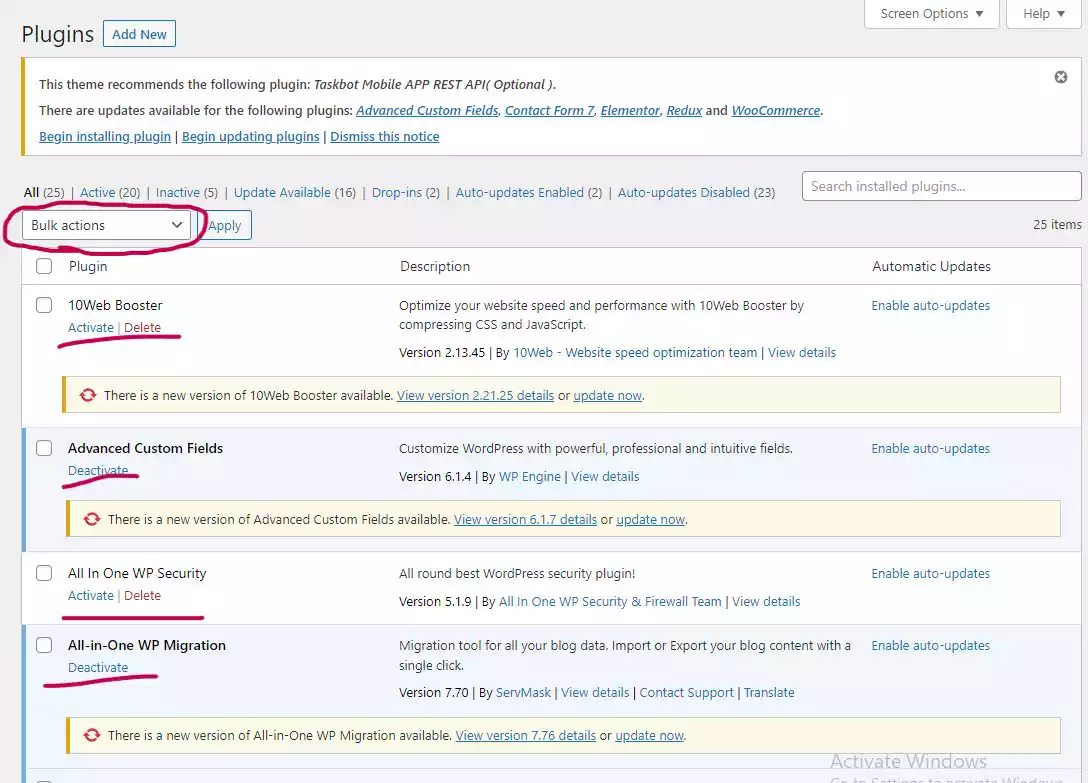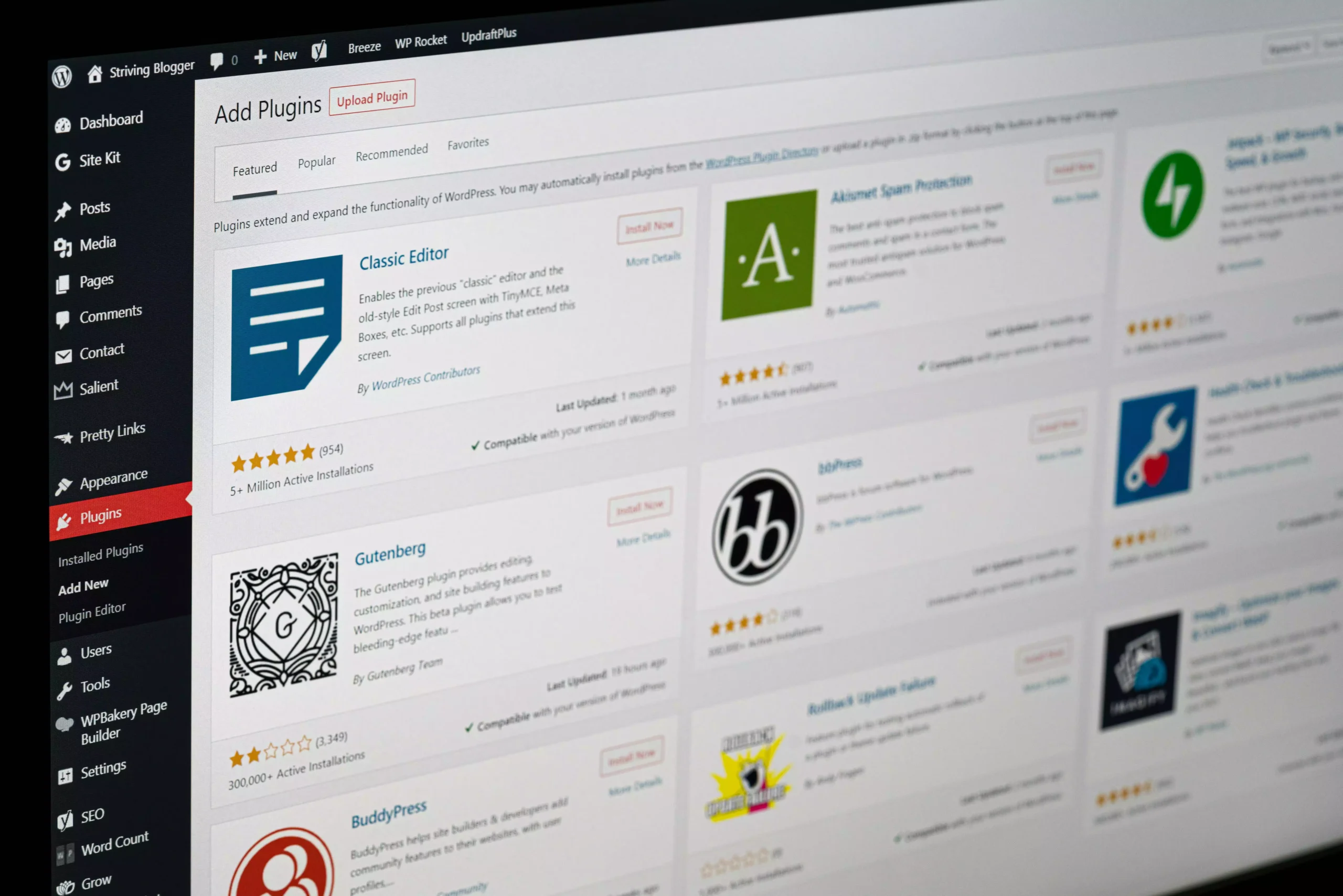Learn how to effectively use WordPress plugins with this comprehensive guide for beginners. Discover step-by-step instructions, best practices, and troubleshooting tips to enhance your website’s functionality and customization.
Table of Contents
Introduction
WordPress is an influential content management system (CMS) that empowers users to effortlessly create and oversee websites. One of the key reasons for its popularity is the availability of a vast array of plugins that enhance functionality and add exciting features to your WordPress site. Whether you want to improve SEO, enhance security, or add social media sharing options, WordPress plugins have got you covered.
In this article, we will explore the world of WordPress plugins and provide a step-by-step guide on how to use WordPress plugins effectively. Whether you’re a beginner or have some experience with WordPress, this guide will help you navigate the world of plugins and make the most out of them. So, let’s dive in!
Section 1: What are WordPress Plugins?
A WordPress plugin is valuable additional software that can be easily installed on your WordPress site to expand its capabilities. They act as applications, granting you the power to enhance and personalize your website without the need for coding. These plugins seamlessly integrate with WordPress, allowing you to tailor your site according to your specific requirements.
The official WordPress Plugin Directory provides access to a vast collection of plugins, covering a diverse range of categories like SEO, security, e-commerce, contact forms, and social media integration. This extensive selection allows you to find a plugin that fulfills your desired functionality. To utilize WordPress plugins effectively, you can simply install them from the directory and activate them on your site, thereby empowering your website with new features and possibilities.
Section 2: Finding and Installing Plugins

Finding and installing plugins is a straightforward process in WordPress. Follow These Simple Steps to Begin your Journey:
- Using WordPress Plugin: To access the Plugin Directory and make use of WordPress plugins, start by logging in to your WordPress dashboard. After successfully logging in, proceed to the ‘Plugins’ section within the navigation menu. In this section, you’ll find a range of options to enhance your WordPress website.
- Exploring and Discovering Plugins: When it comes to WordPress plugins, there are several ways to find the right ones for your website. You can explore featured plugins or check out the popular ones. Additionally, you can search for specific plugins by using relevant keywords. The plugin search bar enables you to discover plugins based on their functionality, author, or tag.
- Assessing Plugin Choices: When selecting a plugin, it’s crucial to consider certain factors. Take note of the ratings and reviews provided by other users. Additionally, ensure the plugin is compatible with your current WordPress version. It’s also wise to take into account the reputation of the developer. Lastly, pay attention to the last updated date, as plugins that are regularly updated tend to be more secure and compatible with the latest WordPress version.
- Installing and Activating Plugins: Once you have identified a WordPress plugin that suits your needs, the installation process is simple. Click on the “Install Now” button next to the desired plugin, and WordPress will automatically download and install it for you. After installation, click the “Activate” button to make the plugin active on your website. With these steps, you can effectively utilize WordPress plugins to enhance the functionality of your site.
Section 3: Managing Plugins

After installing and activating plugins, you can manage them efficiently using the WordPress dashboard. Here’s how:
- Accessing the WordPress Plugins Page: To utilize WordPress plugins effectively, navigate to the “Plugins” section within your WordPress dashboard. This specific page grants you access to a comprehensive list of all installed plugins, showcasing their current status as either active or inactive.
- Activating and Deactivating Plugins: To enable or disable a WordPress plugin, simply click on the “Activate” or “Deactivate” button located next to it. Activated plugins are actively running on your website, while deactivated plugins are temporarily disabled.
- Managing Plugin Settings: Numerous WordPress plugins provide customizable settings, allowing you to tailor their functionality according to your specific requirements. To access the settings of a particular plugin, click on the “Settings” link below the plugin’s name. This action will redirect you to the plugin’s designated settings page, where you can configure various options to suit your needs.
- Removing Unwanted Plugins: If you decide that a particular WordPress plugin is no longer necessary, you have the option to delete it from your WordPress site. To perform this task, navigate to the “Plugins” page, locate the plugin you wish to remove, and click on the “Delete” button situated below it. Exercise caution when deleting plugins, as this action may permanently remove any associated data.
Section 4: Essential Plugins for Every Website

While the plugin selection depends on the specific needs of your website, certain plugins are commonly recommended for almost every WordPress site. Here are some essential plugin categories and examples:
- SEO Plugins: Improve your website’s search engine visibility with plugins like Rank Math or Yoast SEO. These plugins provide tools for optimizing your site’s content, meta tags, XML sitemaps, and more.
- Security Plugins: Enhance the security of your website with plugins such as Wordfence Security or Sucuri. These plugins provide excellent features like malware scanning, firewall protection, login security, and monitoring.
- Performance Optimization Plugins: Optimize your site’s speed and performance using plugins like WP Rocket or W3 Total Cache. These plugins provide caching, minification, and other performance optimization features to help your site load faster.
- Contact Form Plugins: Easily create and manage contact forms on your site with plugins like Contact Form 7 or WPForms. These plugins allow you to design and customize forms and receive submissions via email.
- Social Media Plugins: Integrate social media sharing buttons, follow buttons, or social media feeds using plugins like Shared Counts or Smash Balloon Social Photo Feed. These plugins help boost your site’s social media presence and engagement. Learn More
Section 5: Customizing and Configuring Plugins
Once you have installed plugins, you may want to customize their settings to align with your specific requirements. Here’s how you can customize and configure plugins in WordPress:
- Accessing Plugin Settings: To customize a WordPress plugin, navigate to the “Plugins” section in your WordPress dashboard. Locate the desired plugin and click on the “Settings” link below its name. This action will take you to the plugin’s configuration page.
- Configuring Plugin Options: Each WordPress plugin comes with its own set of configuration options. These options cover various aspects such as general settings, styling choices, third-party service integration, and more. Adjust these settings according to your preferences, and remember to save the changes.
- Extending Plugins with Add-ons: Many WordPress plugins offer additional functionality through add-ons or extensions. For instance, e-commerce plugins like WooCommerce provide various add-ons for specific features such as payment gateways or shipping methods. Explore these add-ons to expand the capabilities of your chosen plugin.
- Customizing Plugin Display: Certain WordPress plugins provide options to customize their appearance on your website. This includes modifying colors, fonts, layouts, and more to match your site’s design. Look for customization options within the plugin’s settings or in your WordPress theme’s customization panel.
Section 6: Updating and Maintaining Plugins

Regularly updating and maintaining your plugins is crucial to keep your website secure and functioning optimally. Here are some best practices for managing plugin updates:
- Keeping WordPress Plugins Updated: Regularly check for plugin updates to ensure you are using the latest versions. WordPress will notify you of available updates in the “Plugins” section of your dashboard. These updates often include enhancements, bug fixes, security improvements, and better compatibility.
- Updating WordPress Plugins Safely: Before proceeding with plugin updates, it is crucial to create a backup of your website. This backup will allow you to restore your site to a previous state in case any issues arise during the update process. Additionally, always check if your theme and other plugins are compatible with the updated version before proceeding with the update.
- Testing Your Website after Updating Plugins: After you’ve updated the WordPress plugin, thoroughly test your website to ensure everything is functioning correctly. Check that all the plugin’s features are working as expected and that there are no compatibility problems with other plugins or your theme.
- Removing Unused WordPress Plugins: It’s essential to regularly review your installed WordPress plugins and remove any that are no longer in use. Unused plugins can pose security risks and unnecessarily slow down your website. By removing them, you can maintain a lean and secure website, ensuring optimal performance.
Section 7: Best Practices for Using Plugins
Optimize Your WordPress Plugin Usage with These Effective Strategies:
- Limiting Number of WordPress Plugins: Although WordPress plugins offer valuable functionality, using an excessive number of them can significantly impact your website’s performance. It’s crucial to install only the necessary plugins and regularly assess if any can be replaced by a single multipurpose plugin.
- Research and Choose Reliable WordPress Plugins: Before installing any WordPress plugin, it’s essential to conduct thorough research. Check the plugin’s reputation, read reviews from other users, and verify its compatibility and update frequency. Stick to reputable plugin developers and avoid plugins with low ratings or a history of security vulnerabilities.
- Ensure Plugin Compatibility: When selecting and installing WordPress plugins, it’s crucial to ensure their compatibility with your WordPress version and other installed plugins. Incompatible plugins can cause conflicts, leading to broken functionality or errors on your website. Always check the compatibility information provided by the plugin developers.
- Regularly Backup Your WordPress Website: Performing regular backups of your entire WordPress website, including the database and files, is essential. Backups are crucial for disaster recovery, especially if any issues arise after installing or updating plugins. In case of any problems, you can restore your website to a previous working state using the backup files.
- Use Secure WordPress Plugins from Trusted Sources: It’s important to download WordPress plugins only from reputable sources such as the official WordPress Plugin Directory or well-known commercial plugin providers. These sources have strict quality control measures and ensure that the plugins available are secure and reliable. Avoid downloading plugins from suspicious websites or unreliable sources, as they may contain malicious code that can compromise your website’s security.
Section 8: Troubleshooting Common Plugin Issues
Despite taking precautions, you may encounter issues with plugins. Here are some common plugin-related problems and how to troubleshoot them:
Plugin Conflicts: Conflicts between WordPress plugins can result in unexpected errors or break specific features on your site. To identify the problematic plugin, follow these steps:
- Deactivate plugins one by one.
- Test your website after each deactivation to see if the issue persists.
- Once you find the conflicting plugin, consider finding an alternative or reach out to the plugin developer for assistance.
White Screen of Death: Encountering a blank white screen on your website after activating a plugin signals a fatal error. To address this problem:
- Access your website’s file system using FTP or a file manager.
- Navigate to the plugins folder.
- Locate the folder of the suspected plugin and rename it to deactivate it.
- This will allow you to access your site again and troubleshoot the problematic plugin further.
Slow Website Performance: Certain WordPress plugins may impact your website’s speed, leading to slow loading times. To improve performance:
- Deactivate plugins one by one to identify if any specific plugin is causing the slowdown.
- Monitor your website’s speed after each deactivation to see if it improves.
- Alternatively, consider using a caching plugin to optimize your site’s performance and reduce loading times.
Plugin Incompatibility: Compatibility issues can arise between WordPress plugins, themes, or other components on your website. To troubleshoot plugin incompatibility:
- Check the plugin’s documentation or support forum for troubleshooting steps.
- If you encounter issues, consider reaching out to the plugin developer for assistance or looking for alternative plugins that are known to work well with your theme and other existing plugins.
Section 9: Conclusion
WordPress plugins are valuable tools that allow you to customize and enhance your website’s functionality. By following the steps outlined in this comprehensive guide, you can confidently search for, install, manage, and configure WordPress plugins. Remember to stay vigilant and regularly update your plugins to keep your website secure and up to date. With the right plugins and best practices in place, you can create a powerful and engaging website tailored to your needs. Enjoy exploring the endless possibilities that WordPress plugins offer!
FAQs

Are WordPress plugins free?
Many WordPress plugins are available for free in the official WordPress Plugin Directory. However, some plugins may offer premium versions with additional features or dedicated support. These premium plugins usually require a purchase or subscription.
Can I install plugins on a WordPress.com website?
WordPress.com offers a limited selection of pre-approved plugins for its users, depending on the hosting plan. If you’re using WordPress.com, you may need to upgrade to a higher plan or consider using the self-hosted version of WordPress (WordPress.org) to have more flexibility in installing and managing plugins.
Can I use multiple plugins for the same functionality?
While it’s possible to use multiple plugins for similar functionalities, it’s generally recommended to avoid redundancy. Using too many plugins that perform the same function can increase the risk of conflicts and negatively impact your website’s performance. Choose one reliable plugin that fulfills your requirements and offers the necessary features.
How do I know if a plugin is safe to use?
To ensure the safety of a plugin, consider the following:
- Check the plugin’s rating and read user reviews in the WordPress Plugin Directory.
- Look for a high number of active installations and regular updates, indicating an active developer community.
- Ensure the plugin is suitable for your WordPress version by performing compatibility verification.
- Check if the plugin has been tested and approved by WordPress.
Can I customize the appearance of the plugins?
The customization options for plugins vary depending on the specific plugin. Some plugins provide built-in customization settings, while others may require you to modify code or use additional plugins for styling purposes. Check the plugin’s documentation or settings page to explore the available customization options.
What should I do if a plugin breaks my website?
If a plugin causes issues with your website, the first step is to deactivate the problematic plugin. Disable the plugin by navigating to the “Plugins” tab within your WordPress admin panel and selecting the “Deactivate” option. If you’re unable to access the dashboard due to the plugin issue, you can use FTP or a file manager to rename the plugin’s folder, which will automatically deactivate it.
How often should I update my plugins?
Regularly updating your plugins is crucial for maintaining the security and functionality of your website. Check for plugin updates at least once a month or enable automatic updates if available. However, before updating, ensure that you have a recent backup of your website, as updates can sometimes cause compatibility issues or unexpected errors.
Can I request support or assistance for a plugin?
Most plugin developers offer support through various channels, such as support forums, documentation, or dedicated support tickets. If you encounter issues or need assistance with a plugin, visit the plugin’s support page or the developer’s website to explore the available support options. Be sure to provide detailed information about the problem you’re facing to receive effective support.
Can I create my custom plugins?
Yes, if you have programming skills or access to a developer, you can create custom plugins tailored to your specific needs. WordPress provides extensive documentation and resources for plugin development, including the WordPress Plugin Handbook. Custom plugins allow you to add unique functionality to your website and have full control over its implementation.
How can I keep track of installed plugins and their updates?
The WordPress dashboard provides a dedicated “Plugins” section where you can manage all your installed plugins. From there, you can view the status of each plugin, check for updates, activate or deactivate plugins, and access their settings. WordPress also provides notifications.













